Russia #3 – Crossing Siberia 2 – Chita to Khabarovsk – November 2014
Leaving Chita, the roads had been plowed and were nearly dry. We made good time. There were very few people or villages now, since previously this was only a “cart road” or nothing; deep permafrost mud in the summer and impassable snow in the winter and no bridges. The Trans-Siberian Highway is the unofficial name for a network of federal highways which span over 11,000 kilometers, (6,800 mi), of Russia, crossing the country from Saint Petersburg on the Baltic Sea (Atlantic Ocean) to Vladivostok on the Sea of Japan (Pacific Ocean). Much of the route parallels that of the existing Trans-Siberian Railway. It is one of the world’s longest national highways.
Fellow Travelers along the Amur Highway
Construction on the “Chita-Khabarovsk” road section was started back in 1977 by the military. By 2004 it was officially opened with gravel and in 2010 it was mostly paved. In a famous PR junket, Vladimir Putin drove a short section of the newly-finished Amur Highway in a yellow Lada. So now there was a thru route, except for a few muddy detours and bridges being rebuilt. On a road like this, like the Alaskan Highway, it will always be “under construction”.
A village called Never
The only stop we made of interest was Never. This ramshackle town seemed mostly abandoned. No gas station, only a small store. Back in 1996, before the highway was completed, this was the turnoff for a gravel road north to Tynda. We were told that hundreds of right-hand drive cars from Japan were smuggled in past customs to Yakutsk on the Lena River. The small houses were the classic style we had seen all over rural Russia, with their pretty hand-painted window frames. You could probably rent one for almost nothing.
Blizzard, snowy roads and black ice
There were occasional turnouts where trucks stopped overnight and we took advantage of those. On one occasion, someone had abandoned two cute puppies. We gave them some bowls of warm milk & bread and they loved it. Russian truck drivers were always friendly and excited to see our truck. Getting diesel was not a problem, but we had to make sure we were using the pump with the lowest temperature grade of “winter diesel” available. Even then, we still added Amsoil Diesel Cold Flow and Diesel Injector Clean additives if there was any question. “Summer” diesel had lubricants that would freeze and clog up our fuel filters.
A nice Welcome to Khabarovsk
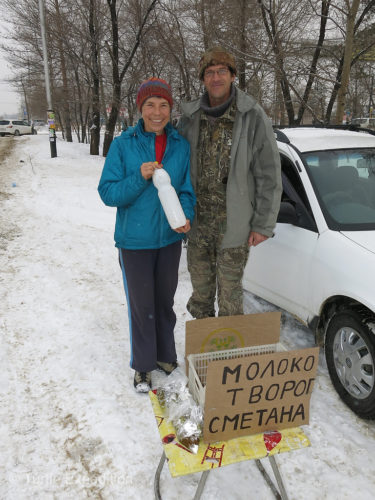
In the morning this man was selling fresh milk. He welcomed us to Khabarovsk with a complementary liter.
As another approaching blizzard became more threatening, we again locked the hubs. In the extreme cold I had to use a crescent wrench to turn the lock knobs on our Dynaloc Hubs. Battling near whiteout conditions, we stopped early. The temperature outside was -18°F (-28°C). Our dual-pane Dometic Seitz windows helped keep the cold out, but our little single-pane window on the door iced over in the morning. We slept warm with our Eberspaecher Airtronic humming away on its maintenance mode. The honeycomb Nida Core walls, floor and ceiling of The Turtle V have a high insulation R-value rating.
Serious Trouble struck one chilly Morning
In the morning, after preheating the engine with our Eberspaecher D5 Hydronic Coolant Heater, the engine started quickly, pushing warm air into the cab. From where we were parked, I made a quick sharp U-turn. I had forgotten that the power steering system was not being warmed by the engine. There was a disturbing “squeal” and a “whoosh” sound. A seal on our power steering hose had blown or a hose had ruptured in the cold. A yellow puddle of power steering fluid in the snow made the possible disaster obvious. I quickly refilled the remote power steering reservoir, and after warming up the system, the blown seal miraculously repaired itself. Wheeeeeue!!! I was wondering where I might get a new hose made at a hydraulic shop in the middle of Siberia—in the middle of nowhere. Joke!!
Thermidors/Utilidors
With great relief, we continued onto Khabarovsk the next day. Khabarovsk is the largest city and the administrative center of Khabarovsk Krai. Just 30 kilometers, (19 miles), from the Chinese border, it sits at the confluence of the Amur and Ussuri rivers. It is the second largest city in the Russian Far East, after Vladivostok.
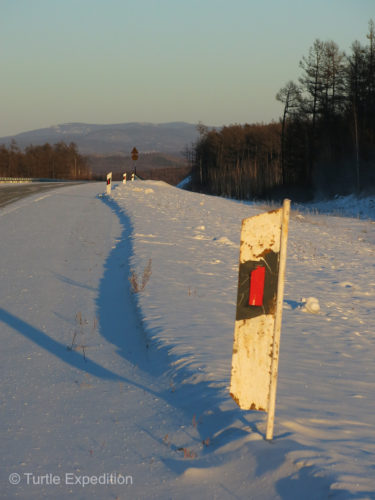 Arriving at night, the temperature was way below freezing, but people were still walking around and shopping. It reminded me of some Russian sayings. “It takes twenty dumb animals to make a fur coat, (mink, otter, fox, rabbit), but only one dumb animal not to wear one.” And, “There is no bad weather. Only people wearing the wrong clothes.” We donned our North Face down jackets and Sorel winter boots and joined the locals on the street. We had found a perfect place to park for a night or two just across from a supermarket. In the morning a man was selling fresh milk in front of our truck and he gave us a complementary liter as a welcome gift. A few blocks away we found a place where locals were getting water and we were able to filled our tank, one 5-gallon bucket at a time. With a little time to spare, we stayed an extra day to relax from our grueling drive. The next leg to Vladivostok was only 759 km, (471 miles), so if the road was plowed we could make it in a day—-or two. Heading south now the weather should improve.
Arriving at night, the temperature was way below freezing, but people were still walking around and shopping. It reminded me of some Russian sayings. “It takes twenty dumb animals to make a fur coat, (mink, otter, fox, rabbit), but only one dumb animal not to wear one.” And, “There is no bad weather. Only people wearing the wrong clothes.” We donned our North Face down jackets and Sorel winter boots and joined the locals on the street. We had found a perfect place to park for a night or two just across from a supermarket. In the morning a man was selling fresh milk in front of our truck and he gave us a complementary liter as a welcome gift. A few blocks away we found a place where locals were getting water and we were able to filled our tank, one 5-gallon bucket at a time. With a little time to spare, we stayed an extra day to relax from our grueling drive. The next leg to Vladivostok was only 759 km, (471 miles), so if the road was plowed we could make it in a day—-or two. Heading south now the weather should improve.
- Drive, drive, drive 12 hours a day. Not a lot of scenery on this highway.
- In a famous PR junket, Vladimir Putin drove a short section of the newly-finished Amur Highway in a yellow Lada.
- The Trans-Siberian Highway route parallels that of the earlier Trans-Siberian Railway. It is one of the world’s longest national highways.
- Check out the icicles on the roof of this passenger carriage!
- Railroad maintenance workers were transported in these vehicles.
- We think this is a Monument to a WW II soldier along side the road. A Russian friend just sent the translation: With memories, a soldier stays alive.
- Someone had abandoned these two adorable puppies at a wide spot in the road.
- We gave the puppies some warm milk and bread and were crossing our fingers that a kind sole would rescue them from the cold.
- Our fellow travelers on this isolated stretch were truck drivers.
- The small houses in Never were the classic style we had seen all over rural Siberia, with their pretty hand-painted window frames.
- Houses in villages were heated with firewood or coal.
- This bus stop in Never didn’t protect much from the cold.
- Russian saying: “There is no bad weather. Only people wearing the wrong clothes.”
- Russian street signs were the same as in Europe.
- Getting fuel was not a problem, but we had to make sure we were using the pump with the lowest temperature grade of “winter diesel” available. Even then, we still added Amsoil Diesel Cold Flow and Diesel Injector Clean additives if there was any question.
- The fuel stations along the Amur Hwy were very modern.
- In the extreme cold I had to use a crescent wrench to turn the lock knobs on our Dynaloc Hubs.
- Sweeping corners were rare and a little scary.
- There were many communication towers along the Amur Highway.
- In order to get to Vladivostok on time, we often had to drive after sunset.
- The 12-day marathon drive through several winter storms was quite challenging at times.
- It was helpful that traffic was very light. They could be hard to see in a whiteout.
- The temperature outside was -18°F (-28°C). Our dual-pane Dometic Seitz windows helped keep the cold out, but our little single-pane window on the door iced over in the morning.
- We slept warm with our Eberspaecher Airtronic humming away on its maintenance mode. The honeycomb Nida Core walls, floor and ceiling of The Turtle V have a high insulation R-value rating.
- The extreme cold temperatures of Siberia can be exciting and beautiful at the same time.
- Another stop for the night.
- We could park at truck stops overnight. After pre-heating the engine with our Eberspaecher D5 Hydronic Coolant Heater, the engine had no problem starting, but the power steering was still very cold.
- Despite the frigid temperature, people were still walking around and shopping.
- This is one of several beautiful Russian Orthodox churches in Khabarovsk.
- Our parking/camping site across from a bank and supermarket was quiet at night.
- We did find a place where locals were getting water and we filled our tank, one bucket at a time.
- The lower green sign on the store across the street said in Russian—sort of—“supermarket”. It turned out to be an expensive luxury delicatessen and liquor store.
- A quick glance at the La Crosse Technology gauge next to our bed gives us indoor and outdoor temperatures and lows and highs. (This screen is showing Nevada City in January where we live.)
- All 12-Volt DC and 110-Volt AC are controlled by our Xantrex PROsine 2.0 and Blue Sea marine circuit breakers. A Solar Boost 2000E monitors the solar panels.
- Our Eberspaecher D5 Hydronic, (far right), heats our water, pre-heats the engine and can also heat the camper, or all three at once, depending on how we set the valves to the transfer manifolds, (center).
- In case you wondered, we have learned a few things after traveling in campers for 47 years. All controls for heaters, pre-heaters, music, rechargeable COAST flashlight, 110 and 12 volt power and a remote GoLight are right next to the bed—OH, and a cubby hole for my morning coffee.






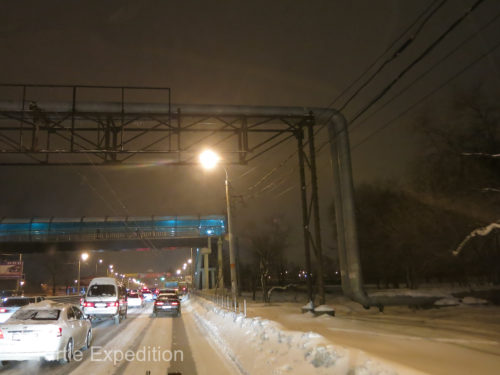
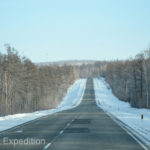

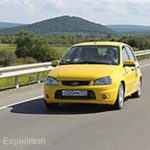

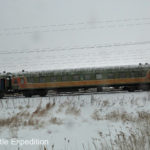

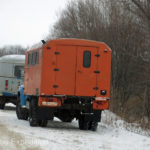
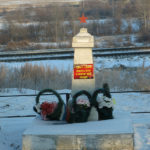

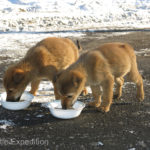


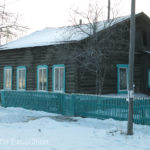
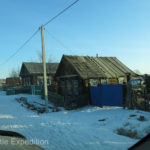

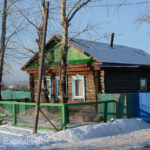
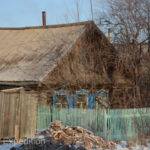


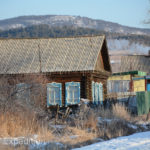

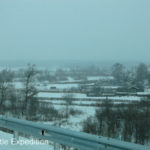



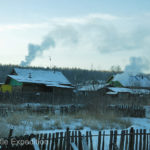
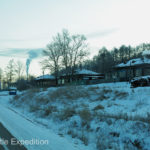

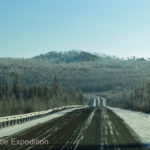


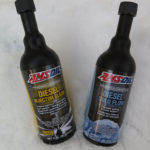

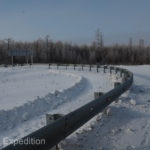
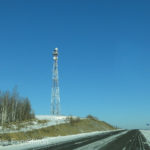
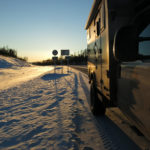
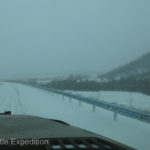

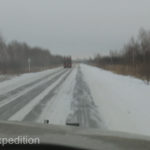



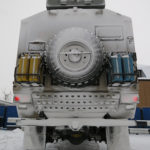

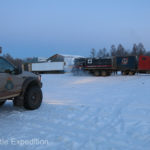
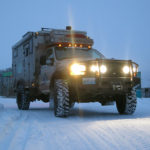

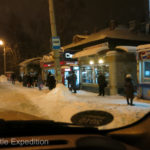

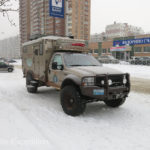
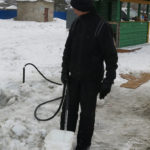

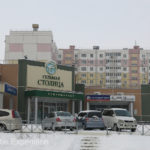

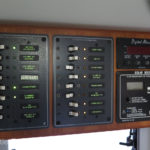
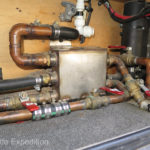
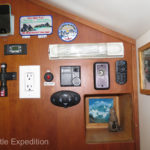





Hi Gary & Monika,
I’m enjoying your stories from Russia. I’m sure the extreme cold presented some interesting challenges. Is your espar hydronic mounted inside or outside the insulated camper? My espar airtronic is inside the camper but the hydronic is outside the camper. It can have trouble starting when temps get into the single digits and I wish it was inside. I am in the process of designing a diverter from the airtronic exhaust so I can pipe it into an insulated housing to preheat the hydronic to make sure it will start so I can then preheat the engine when in single digits or below. I would have the airtronic running all night anyway in those temps so it would always have hot exhaust available for heating the hydronic unit. How long do you run your hydronic before starting your engine? Seems like I have to run it at least 20 min to make a difference. Do you insulate any of your fuel lines? Do you use any silicone electric heating pads for freeze protect purposes? Any other extreme cold tips that I could leverage into my ER?
Thanks,
Jason
Hi Jason. Sorry, we just discovered your comment. When we drove across Siberia in 1996, conditions were considerably different than they are now but the cold is probably the same. We saw temperatures down to -86F. We did not have an Airtronic in The Turtle IV. During our recent crossing of Siberia in the winter, we had no problem starting our D5 Hydronic in temperatures down to -20F. It is mounted in an outside compartment but it gets some residual heat from the camper because the Airtronic is against the same wall on the inside. We typically let it run for 20 minutes before starting the engine. At temperatures below -40F as we experienced in 1996, we left the engine running 24 hours a day because the belts and the power steering pump were not protected from the cold. Our fuel lines are not insulated but we do use Amsoil AntiGel in the diesel tanks and our secondary auxiliary Racor fuel/water separator has a heating plate. We have not used any heating pads for our grey water tank but I am considering installing one. Normally we just leave the valve open in extreme cold temperatures (where we can do that) or use a water basin in the sink to collect the water. We have a Deflect-a-Shield winter guard on the front grill which blocks cold air from coming in. In The Turtle IV we had battery warmers, block warmers and oil pan warmers which were powered by our 5000 W diesel generator in the trailer. We never used them below -40F because again, the belts and power steering were not protected. In those extreme temperatures, Russian truckers taught us to move the vehicle 3 times every five min. because the tires melt the snow and then they freeze to the ground. You will drive out of your wheels in the morning. The other things we learned is that you have to start driving at 5mph for the first 5-10 min. to warm up gear oils which are jello like in those temperatures. All that said it depends where you are going and how cold it is. -86F is much different than -20F. Send us an email to wescott@turtleexpedition.com if you have more questions. Best regards, Gary
To write a beautiful post it is very important to write a beautiful content and you have created a very nice design and I got a lot of inspiration from your post and I also want to have nice and beautiful post like you in my life.